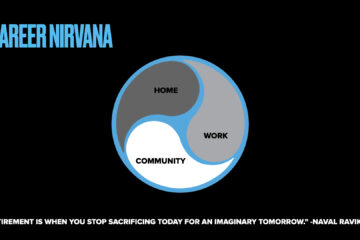Career nirvana is achieved when your community, work, and personal life are in harmony. This state of mind comes from happiness, health, and wealth emanating from the freedom to do whatever you’re best at with people you care about.
There is little holding you back from achieving such splendor. Start by doing remarkable work you enjoy. This creativity earns attention and delivers intellectual, human, financial, network, cultural, physical, and institutional capital. As we learn from The Startup Community Way, the Seven Capitals keep you building by using what you have, to attract what you want.
Let passion fuel persistence, then fuse your career portfolio into the entrepreneurial ecosystem. As you connect into community, be generous by accelerating others and use the trust that creates to do it more often. When this becomes routine, your generosity will leave a legacy. For innovators looking to change the world, such a legacy grants enduring satisfaction and furthers the sense of euphoria.
As a fulfilling career is composed, it’s easier to find work-life balance. Remember, we work to live. We don’t live to work. Nobody looks back wishing they had spent more time in the office. Use the freedom you create to embrace those you love while doing more things that make you happy.
Extra Shot
“The peace and satisfaction of building what you truly care about is one of life’s greatest gifts.” –You Don’t Need This Book
This may sound idealistic, but it’s not all rainbows and unicorns. This approach to work requires creativity, immeasurable time, immense ambition, and advanced efficiency. As discussed in the Side Hustles chapter of YDNTB, an acute awareness of your personal bandwidth is essential to optimizing when and how resources are utilized. It can also be tempting to spend too much time on things that are fun but may not have real potential. Be humble enough to recognize what you have and what it will take to evolve your idea(s) into reality. Managing multiple “hobbies that pay” takes serious effort, but the reward is extraordinary work you love talking about and an inner peace that provides transformative happiness.
If you achieve career nirvana, be thankful, but recognize that things will always change. What you have today may not be the same tomorrow. Keep building to enjoy the moment, then make it last with generosity that recycles a sense of abundance for others along the way.
Extra Shot
Cheers to everyone who made last week’s book launch a huge success! Signed softcovers were shipped nationwide and more orders continue to pour in. As you dig into YDNTB, I’d love to see photos, hear what resonates and explore fresh ways to accelerate your work.
